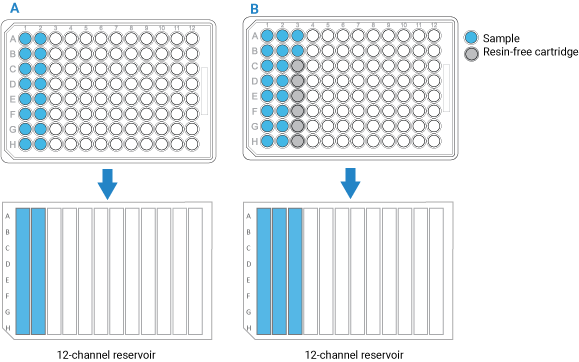Preparing the samples

When preparing the samples, you must:
• Remove macromolecular particulates before the samples are loaded onto AssayMAP cartridges.
• Adjust the buffer composition to optimize the binding conditions (for example, pH).
• Determine the volume of samples to load on the AssayMAP cartridges.
• Transfer the samples to the microplate you want to use for the protocol run.
Removing macromolecular particulates
Make sure the samples are free of macromolecular particulates, such as large protein aggregates and cellular debris to prevent clogging the cartridges. Samples should be filtered through a 0.45‑µm filter or centrifuged at a high g‑force before loading on an AssayMAP cartridge.
Adjusting the buffer composition
Depending on the type of fractionation you are performing the sample should be in a buffer compatible with the stationary phase. For peptide fractionation using SCX cartridges, optimum performance is typically achieved under low salt and low pH conditions. For high- or low-pH peptide fractionation using C18 and RP-S cartridges, samples typically should have a pH of < 3.
Determining the volume of sample to load
The AssayMAP Fractionation protocol permits loading up to 250 µL of sample onto AssayMAP cartridges due to labware capacity limits.
What is the binding capacity of the cartridge?
Two ways to express the binding capacity of a cartridge are quantitative binding capacity and total binding capacity:
• Quantitative binding capacity. The maximum mass of peptide that can bind to the cartridge in a single pass, where less than 10% of the load appears in the flow-through. For reversed-phase cartridges, the quantitative binding capacity is relatively straightforward for a single species of peptide. The quantitative binding capacity for a mixture of peptides is more complex due to the differences in relative hydrophobicity of the peptides, which results in competitive binding in situations where the ratio of binding sites to mass loaded is low.
For examples of how sample mass loaded and the relative hydrophobicity of peptides can affect recovery in a complex peptide mixture, see Agilent Application Note 5991‑2957EN in the “Reference library.
To avoid or minimize sample bias during peptide cleanup, it is critical to load sample masses that are less than the mass at which hydrophillic peptides are lost. See the Agilent AssayMAP Bravo Cartridges Selection Guide for detailed quantitative cartridge binding capacity information for the 5 and 25 µL RP-S and C18 cartridges.
• Total binding capacity. The maximum mass of peptide that can bind to the cartridge. This can only be achieved by loading significantly more peptide than can be bound by the cartridge. This value is significantly greater than the quantitative binding capacity and will result in the loss of hydrophillic peptides. See the Agilent AssayMAP Bravo Cartridges Selection Guide for detailed total binding capacity.
Preparing the sample plates
Planning the microplate setup
Before transferring the samples, you should plan the layout of the samples in the microplate. Consider the following:
• You can process 1 to 96 samples in parallel. The position of the samples in the microplate dictates the positions of the cartridges in the 96AM Cartridge & Tip Seating Station. These positions must also match the locations of the buffer solutions in microplates and reservoirs.
• If you have fewer than 96 samples, make sure the samples occupy full columns in the microplate, as the figure below shows.
The default protocol settings assume that samples will be arranged in multiples of 8 in a column-based configuration. Also, the AssayMAP Bravo Platform applies differential pressure to seat cartridges based on the number of full columns of cartridges. To achieve proper cartridge seating, entire columns must be used.
• If the number of samples you have is not a multiple of 8, use AssayMAP Resin-Free cartridges to fill the empty well positions. This will prevent liquids from dripping on the deck or being dispensed on the deck during the Cup Wash steps.
Figure Example of sample microplate and reservoir layout: A) Multiple of 8, and B) Not a multiple of 8
 |
See Labware for acceptable labware at each deck location.
Transferring the samples to the microplate
You can transfer the samples to the microplate that is supplied with the AssayMAP kits. See Starter kit, cartridges, and labware.
An excess (overage) volume ensures that a microplate well does not fully deplete, which would result in aspiration of air into the syringes and then into the cartridges, compromising performance.
The Reagent Volume Calculator shows the recommended overage for the labware types being used and automatically includes recommended overages in the volume it recommends per well.
Labware-specific overage recommendations are also presented in the Labware Reference Guide, which you can find in the Literature Library page of the Protein Sample Prep Workbench. More or less overage can be used depending on the volatility of the solution and the length of the run but the recommended overages are fine for most standard runs.
To transfer the samples to the microplate:
1 Run the Reagent Transfer utility or Reformatting utility to transfer the samples. For instructions, see one of the following:
2 If necessary, centrifuge the sample labware to remove bubbles.